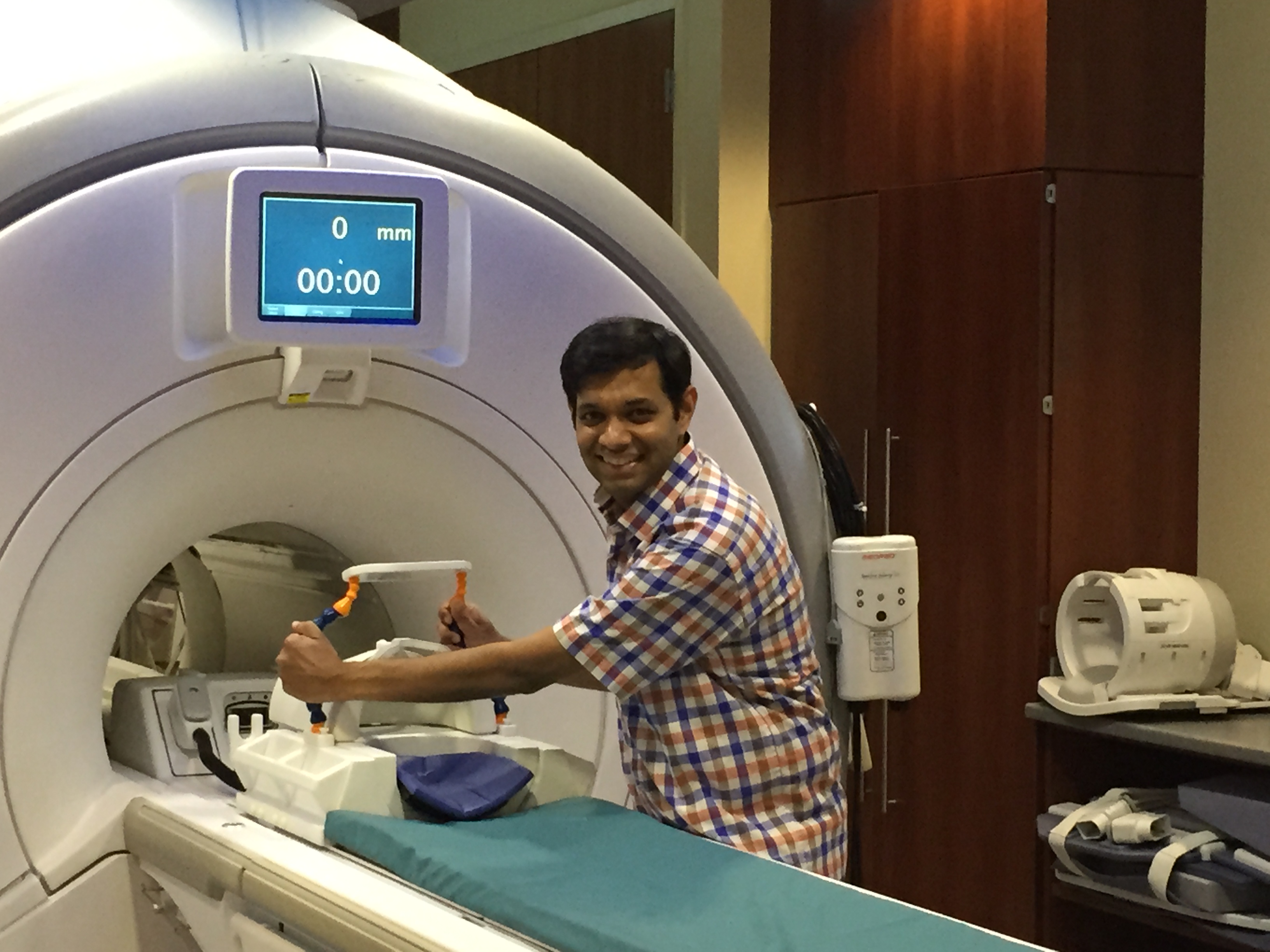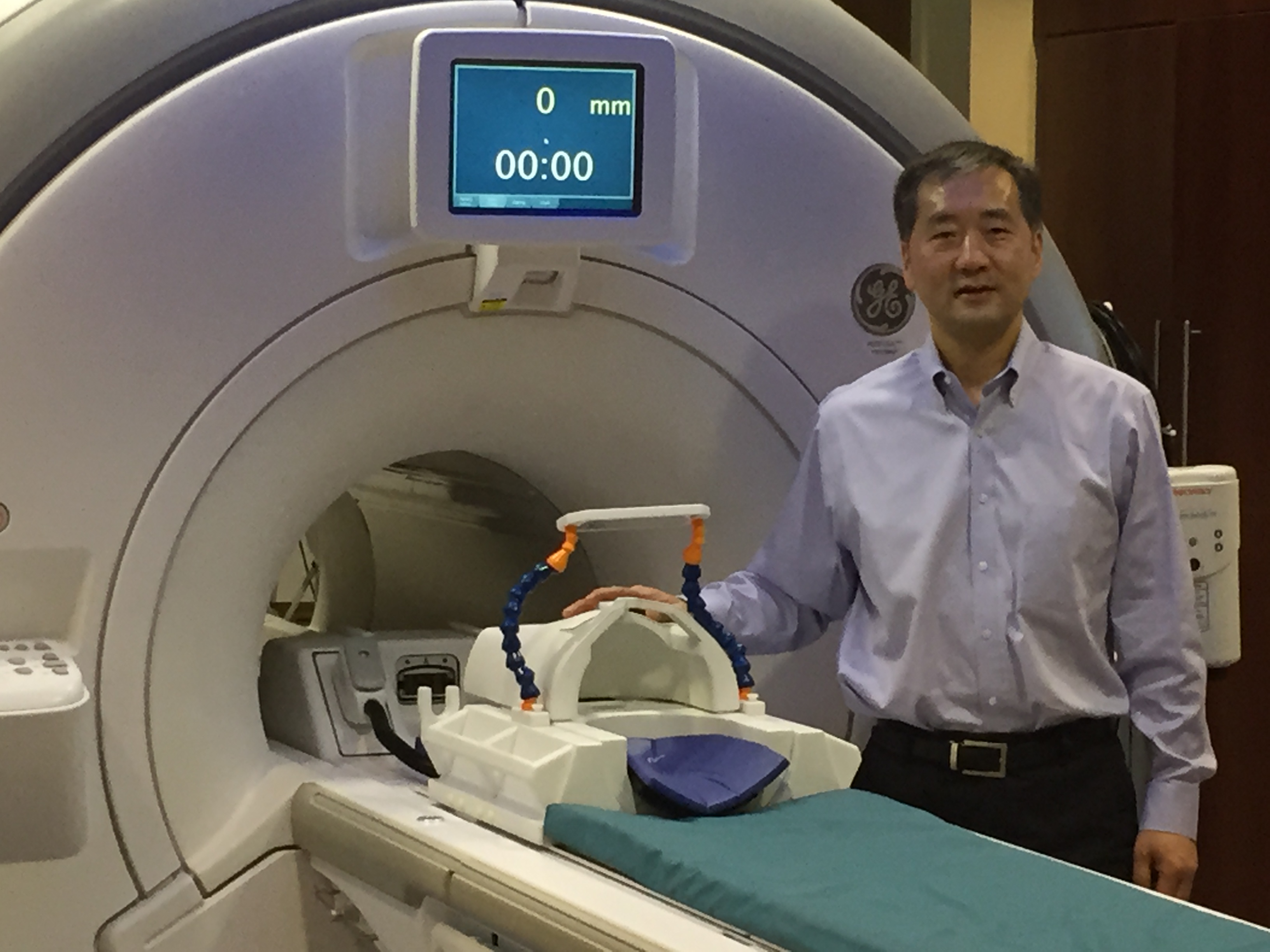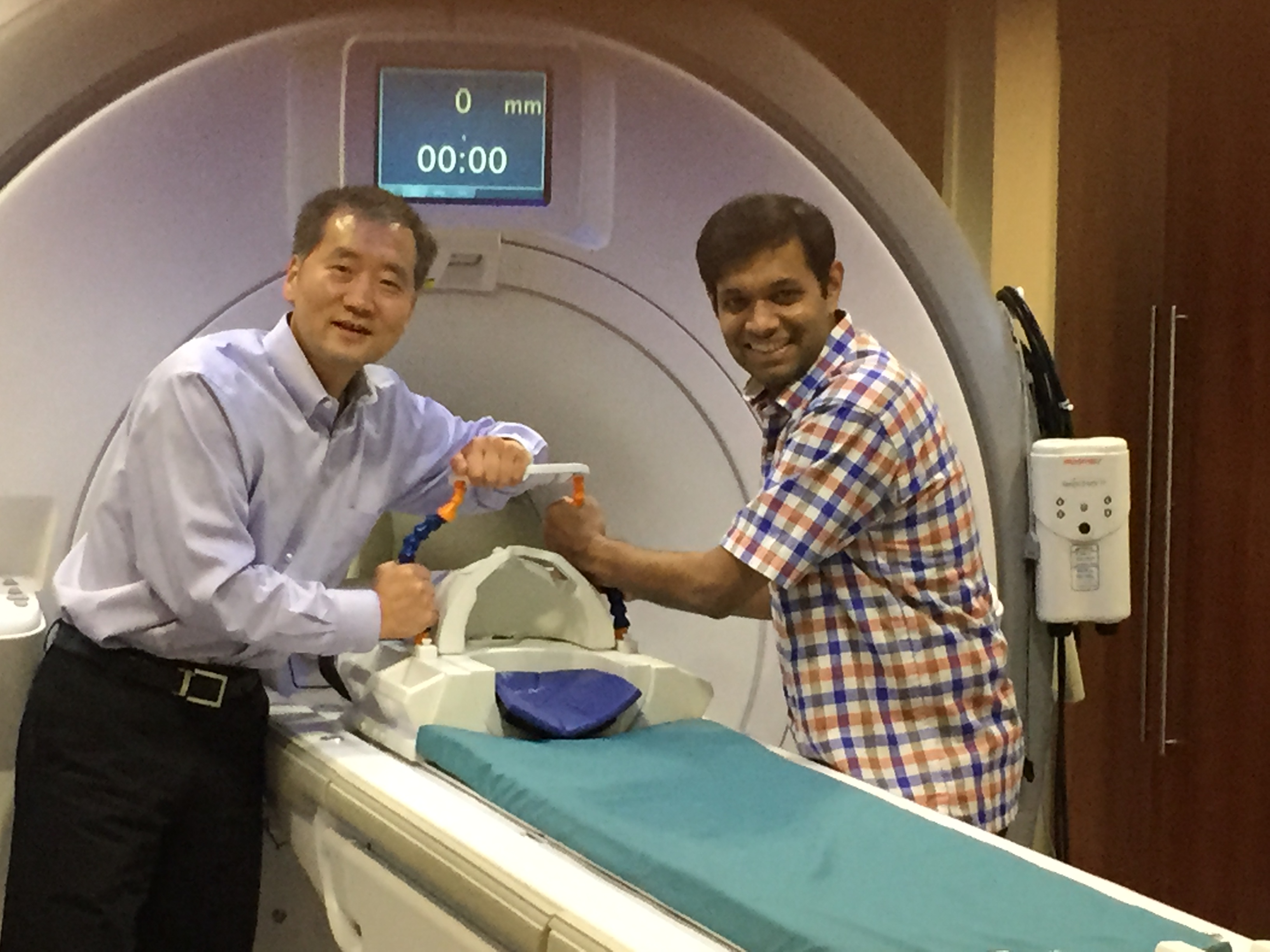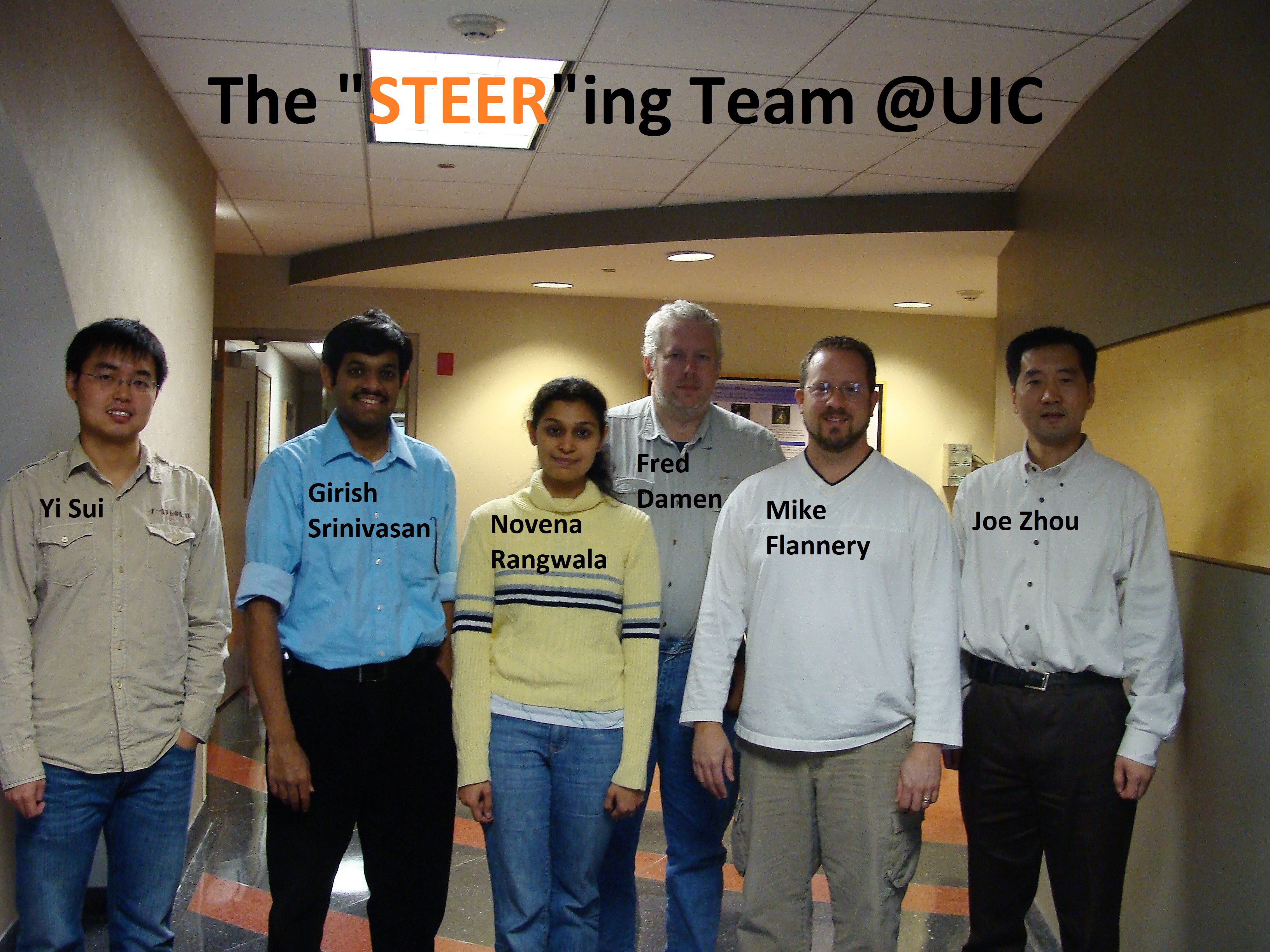

This May we got the inside scoop on Steer-PROP from Dr. Girish Srinivasan and Dr. X. Joe Zhou. Steer-PROP is a GRASE-based PROPELLER sequence that traverses k-space in a new way to reduce the echo train length and the demands on the steering blips while maintaining the ability for robust motion correction. Girish provides some helpful audio slides with lots of great details on the evolution of FSE-PROPELLER to the original GRASE-PROPELLER, Turboprop, to their newest version, Steer-PROP.
MRMH: Thank you guys for joining us!

Joe: Thank you for having us! Reading somebody else’s paper is fun but reading our own paper to learn more is even more fun!
MRMH: Can you tell us a little bit about who you guys are and what lead you to this work?
Girish: My undergraduate and masters were in computer science in India, and I had a strong interest in the medical field. I started this Ph.D. program while I was working full-time at Motorola and that’s when I connected with Dr. Zhou, who had been working a lot on fast spin-echo (FSE). Of course, Dr. Zhou is one of the earliest researchers on FSE optimization and artifact reduction. FSE-based PROPELLER offers a considerable advantage in motion correction and has been used in routine clinical practice but needs improvement in time efficiency. That’s where I came in with my coding background. I started off understanding the sequence, designing and building the sequence, and then taking it to the scanner and evaluating it. Then we added the reconstruction and correction parts.
MRMH: That’s very cool that you got to be involved in all of the pieces of this process from start to finish.
Girish: Absolutely! This has been over the course of about a decade.
Joe: I started in MR physics in 1987, so more than three decades ago. The very first sequence that I was working on as a student was a projection reconstruction sequence. Today we call it radial sampling. Back then the spin-warp sequence was only a few years old, or young. Those two ways of traversing k-space, really amazed me: one is radial and the other is a rectilinear or Cartesian. So, when Jim Pipe’s PROPELLER was published in 1999, I was really intrigued that you could have a sequence that could combine the merit of both. Fortunately, I have Girish in my group and also some other people who are really interested in further improving this wonderful concept.
MRMH: How did Steer-PROP evolve out of GRASE and PROPELLER?
Girish: The initial implementation of PROPELLER was based on an FSE sequence. With each spin echo, you acquire a single line of k-space in Cartesian grid until you get an entire blade in one TR. That’s when you apply the rotation and switch to the subsequent blade. That is basic PROPELLER. Then Dr. Pipe introduced a GRASE-based PROPELLER called Turboprop where each spin echo is divided into multiple gradient echoes. So, your blade becomes much wider.
Because PROPELLER inherently samples the center of k-space over and over again, you can use this redundant information for motion correction. In the Turboprop implementation you have a larger overlap, so you can do an even better job correcting motion artifacts and the time taken to cover all of k-space is shorter compared to standard FSE-PROPELLER. However, the motion correction in the standard FSE-PROPELLER was already pretty good. So the question is “do you really need this additional redundant information or can we use that time towards a better sequence that maintains the merit of PROPELLER?”. Steer-PROP was born out of that.
Joe: In Turboprop you have a mixture of gradient echo and spin echo within a blade. As you know, the phase error is a major problem in GRASE because you have to deal with two types of phase errors, one from the spin echoes and the other from the gradient echoes. In Steer-PROP we can separate out those two phase errors. Within the blade, we only deal with the spin-echo phase errors.

MRMH: What about how it compares with X-PROP?
Girish: X-PROP was a mechanism being formed almost in parallel with Steer-PROP. The biggest difference in the implementation is that after a single TR, Steer-PROP has acquired three adjacent blades and X-PROP has acquired 6 blades that are distributed evenly across the entire k-space region.
Joe: If you look at the mechanism of moving from one blade to the next, in X-PROP you actually need larger steering gradient areas by either increasing the time or using a high gradient amplitude, which can increase eddy currents. The advantage of Steer-PROP is that we don’t use a huge gradient, just a tiny blip to make a small jump in the arc of the circle. Therefore, the eddy currents are virtually negligible.
The concept of doing Steer-PROP was actually proposed 10 years ago. We had a pre-cursor called multi-echo PROP in 2005, which was cited in the X-PROP paper. I give a lot of credits to the X-PROP inventors for, not only coming up with a beautiful concept, but also for getting the publication out really fast. For Steer-PROP, we had our first abstract back in 2010 at the ISMRM meeting, which was well-received, but we took a long route towards journal publication. We spent quite a bit of time to polish the technique and make sure that we had the best possible image quality. Conceptually, those two techniques had roughly the same starting point, and our paper was just published whereas X-PROP was published back in 2011.
MRMH: So, in science there is some art to determining when to publish?
Joe: Exactly, and I can’t say that one way is better than the other but just different ways.
Girish: One thing I really appreciate about Dr. Zhou’s work is getting to that level of perfection that you are satisfied with. Personally, putting that extra effort has been useful in my career so that the audience really says “okay yes this work obviously makes sense”.
MRMH: How did you come up with the name?
Girish: When we were discussing it, we kept talking about the concept of how we would “steer” the blades towards a particular direction, and the name kind of fell out of that.
MRMH: And I see there was a lot of work involved in determining the gradient sizes to “steer” those blades.
Girish: I think that is probably the most time spent. Tons and tons of hours of brainstorming within the lab because the x and y gradients (or blips) used to the corresponding line in the next blade have to be very precise. Otherwise you start losing signal and get streaks and other artifacts.
Joe: Steer-PROP was not the first name that we came up with. We first named it GRASP for a GRASE-based PROPELLER sequence. But later we found out that GRASP was already used for a projection reconstruction sequence. We fully respect the other inventors’ work and didn’t want to create any confusion. We liked the name PROPELLER because it is not only a name but also associated with an action… you are traversing k-space just like a PROPELLER would. We wanted to follow the footsteps of Jim Pipe; “Steer” is really an action that reflects what we are doing in this sequence. So, when Girish came up with “Steer-PROP”, we stuck with it and stopped calling it GRASP.

MRMH: I like that! It’s just like the drink theme in the parallel imaging world with GRAPPA and Caipirinha…
Joe: Exactly, we wanted to follow the path of the other great scientists.
MRMH: Can you speed up Steer-PROP even more with in-plane parallel imaging or simultaneous multislice?
Girish: Both should be possible.
MRMH: But what about SAR limits with all of your 180s?
Joe: That’s the beauty of GRASE-based sequences. The T2 and T2* are what define the data acquisition window allowed. We can split between spin echoes and gradient echoes to best use that time. If you run into a SAR issue, then you can look into lengthening the gradient echo train while shortening the spin echo train.
MRMH: Girish, considering your interest in the medical field, where do you see this fitting into translation to the clinic?
Girish: Because the PROPELLER family sequences are robust against motion, one of the natural next steps is to take this outside of the brain. Diffusion has great potential in body imaging, and this could provide a way to address body motion.
Joe: To apply this technique to body imaging would really present a huge opportunity. And even for the central nervous system, it can be useful to address some unmet needs. For example, substantia nigra in the brainstem is of great interest to studying Parkinson’s disease. In single-shot EPI for DWI, the whole brainstem is kind of a blob and badly distorted. High resolution and distortion-robust Steer-PROP can make a contribution in that area.
MRMH: Well then, we look forward to seeing what you do with Steer-PROP next!




